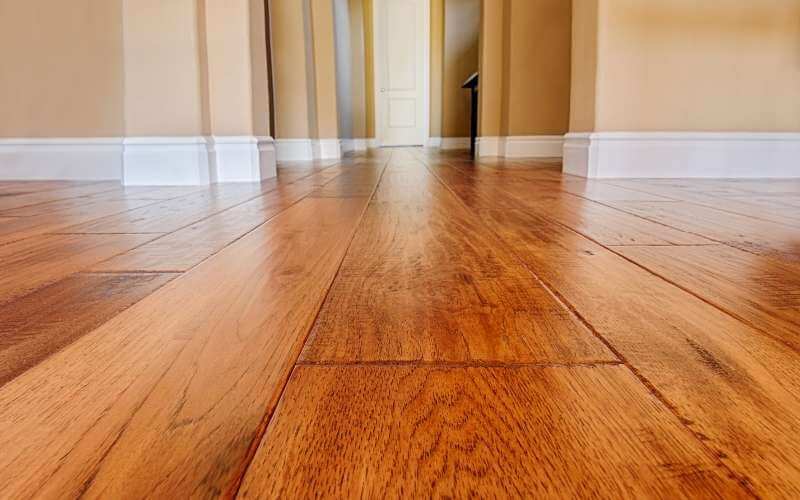One of the most vogue flooring choices is wood. Floors made of wood can be quickly identified by their value, aesthetic, and durability, causing many homeowners to prefer it to other kinds of flooring types.
Paying attention to the physical appearance, wood grain pattern, surface-level damage, age and installation process are a few ways to tell if floors are real hardwood or not.
However, hardwood floors are a selling point that increases home value; not all hardwood floors are hardwood.
You could hardly tell the difference between laminate and hardwood flooring by looking alone because their looks can be pretty similar.
It may look somewhat hard to differentiate between the two, especially if you have no prior knowledge about wood.
So, just because you’re enthralled by the appeal of the wooden flooring in your new home doesn’t mean it is hardwood.
Here’s how to tell if it’s real hardwood or some engineered wood.
Related: How to Protect Hardwood Floors from Bed with Wheels
How to Tell if Floors Are Real Hardwood Floor
Table of Contents
You can tell if a floor is an actual hardwood floor by ascertaining the look of the wood grain pattern, the floor’s age, if the flooring has any surface-level damage as real hardwood can wear quickly, and also by its physical appearance.
Physical Appearance
The easiest way to differentiate between real hardwood and engineered wood is physical appearance. You can use the following steps to differentiate them.
1) pick up a loose plank.
2) Look at the side of the plank.
3) If it is one solid piece of wood with a continuous grain, it’s solid hardwood.
If you see different layers of wood, it’s engineered hardwood. Often, layers of wood will look sandwiched together, but it’s easy to spot.
Surface-Level Damage
Hardwood has no protective layer; they are generally finished with some sealant.
Finishes primarily used in homes for residence are framed to provide water resistance and some level of protection from scratches and other types of wear or tear.
Still, hardwood flooring is by nature softer, and scuffs and scratch, since the finish wears down from daily use.
Softer scuffs and scratches happen since the finish wears down from daily use.
Hardwood floors are given to water staining in a way. Visible watermarks on the wood are another sign that the floor is likely real hardwood.
If you want to be thorough in your examination, scrape some of the finish off because this will allow you to identify the wood flooring more accurately.
Push your fingernail into the finish a bit harder, and if it’s hardwood, the finish will remain unmarked.
Read: How to Fix Hump in Hardwood Floor
Wood Grain Pattern
The floor planks of hardwood are each cut straight from a single piece of wood. Hardwood planks are chosen from trees, usually tight grain with few knots.
Every plank has its unique wood grain pattern, and No two hardwood planks look the same. The hardwood grain lines will be random.
Some planks might have knots, with the results being unique floor plank by floor plank.
By studying the flooring for planks with the exact wood grain patterns and the same knots, you can easily decipher if a floor is genuine hardwood can see a design. If some planks appear to be identical, it’s not real hardwood.
So, look out for the wood grains or growth rings. They should be big and relatively scattered. If it’s reoccurring, you might have a composite floor featuring a wood-like veneer on your hands.
Popular hardwoods have an open pore structure, so the grains are easily visible and look natural.
Installation Process
In the installation process of Hardwood floors, they can be glued directly to the subfloor, and some modern varieties exist that are floating floors.
Still, many hardwood floors physically adhere to the subfloor with either nails or staples. Therefore, existing staples or nails at the wood planks’ edges are a good sign that the floor is real hardwood.
Age
If you can find out when the floor was installed in the house or the floor’s specific age, it could aid you in detecting if it’s real hardwood or not. If the floor was fixed more than 25 years ago and still durable enough, it’s most likely real hardwood.
Read: How to Repurpose Hardwood Flooring (8 Easy Ways)
Conclusion
So, if you’re thinking of buying wood for your flooring or moving into a house with wooden flooring, you can use these factors to know if it’s real hardwood or engineered wood.
However, always make choices that are suitable for your needs.
This article was written to give you in-depth knowledge about how to tell if floors are real hardwood.
By the end of this article, we’re pretty sure you will be able to confidently tell if a floor is real hardwood or not.
It is our sincere hope that this article help give you the knowledge you require, if it did, kindly share it across your social media platforms.

